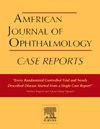异体iPS细胞来源的RPE移植治疗RPE65-LCA的潜力
Q3 Medicine
引用次数: 0
摘要
目的评价诱导多能干细胞(iPS)源性视网膜色素上皮(RPE)移植治疗rpe65相关Leber先天性黑朦(RPE65-LCA)的安全性和治疗效果。观察1例46岁男性RPE65-LCA患者行同种异体iPS细胞来源的RPE移植。患者治疗前最佳矫正视力(VA)为2.0 (logMAR)。将iPS细胞衍生的RPE细胞悬液移植到视网膜下间隙。移植后第15天,由于局部类固醇治疗,眼内压(IOP)升高至46 mmHg,导致VA对光感知(LP)下降。第71天视网膜成像显示大多数移植细胞已经迁移并形成视网膜前膜(ERM)。第112天手术切除ERM。移植两年后,患者报告视力改善,VA从LP改善到1.4 (logMAR)。全视野刺激试验(FST)和显微镜观察显示视网膜敏感性增加。这些改善在治疗后可维持4年之久。结论和重要性:尽管该病例引起了对细胞悬液用于RPE移植的安全性担忧,但RPE移植仍然可以作为RPE65相关视网膜病变患者的潜在治疗选择,特别是那些不符合RPE65基因治疗条件或年龄较大的患者。本文章由计算机程序翻译,如有差异,请以英文原文为准。
Therapeutic potential of allogeneic iPS cell-derived RPE transplantation for RPE65-LCA
Purpose
To evaluate the safety and therapeutic effects of induced pluripotent stem (iPS) cell-derived retinal pigment epithelium (RPE) transplantation for RPE65-associated Leber congenital amaurosis (RPE65-LCA).
Observations
A 46-year-old male patient with RPE65-LCA underwent allogeneic iPS cell-derived RPE transplantation. The patient's best-corrected visual acuity (VA) prior to treatment was 2.0 (logMAR). A cell suspension of iPS cell-derived RPE was transplanted into the subretinal space. On day 15 post-transplantation, intraocular pressure (IOP) increased to 46 mmHg due to local steroid treatment, resulting in a decrease in VA to light perception (LP). Retinal imaging on day 71 revealed that most transplanted cells had migrated and formed an epiretinal membrane (ERM). The ERM was surgically removed on day 112. Two years post-transplantation, the patient reported improved vision, with VA improving to 1.4 (logMAR) from LP. Full-field stimulus testing (FST) and microperimetry demonstrated increased retinal sensitivity. These improvements have been maintained for up to 4 years post-treatment.
Conclusions and importance
Although this case raised safety concerns regarding the use of cell suspension for RPE transplantation, RPE transplantation may still serve as a potential therapeutic option for patients with RPE65-associated retinopathy, particularly those who are not eligible or older age for RPE65 gene therapy.
求助全文
通过发布文献求助,成功后即可免费获取论文全文。
去求助
来源期刊

American Journal of Ophthalmology Case Reports
Medicine-Ophthalmology
CiteScore
2.40
自引率
0.00%
发文量
513
审稿时长
16 weeks
期刊介绍:
The American Journal of Ophthalmology Case Reports is a peer-reviewed, scientific publication that welcomes the submission of original, previously unpublished case report manuscripts directed to ophthalmologists and visual science specialists. The cases shall be challenging and stimulating but shall also be presented in an educational format to engage the readers as if they are working alongside with the caring clinician scientists to manage the patients. Submissions shall be clear, concise, and well-documented reports. Brief reports and case series submissions on specific themes are also very welcome.
 求助内容:
求助内容: 应助结果提醒方式:
应助结果提醒方式:


